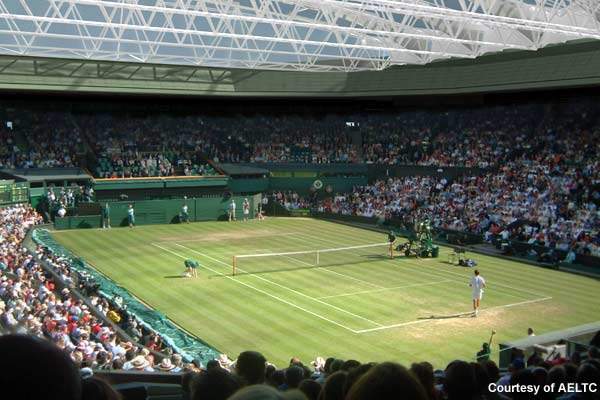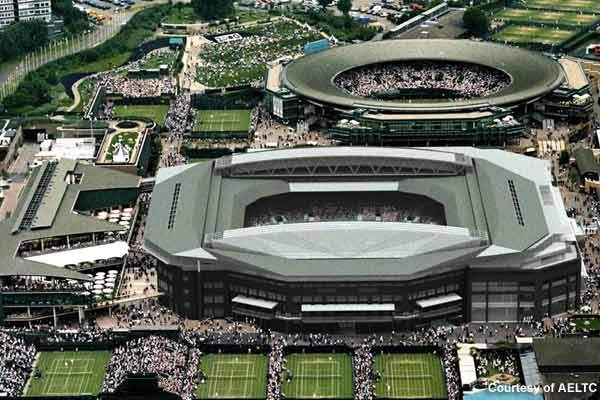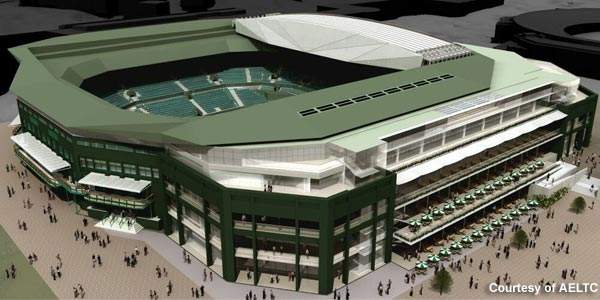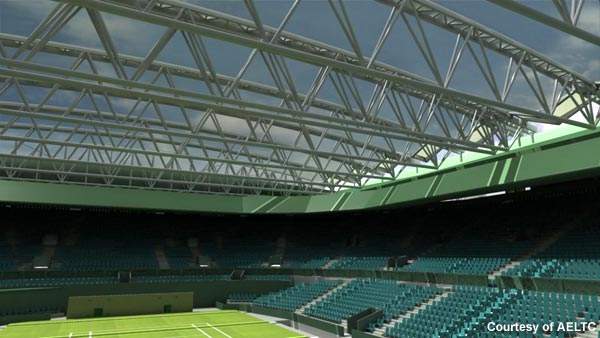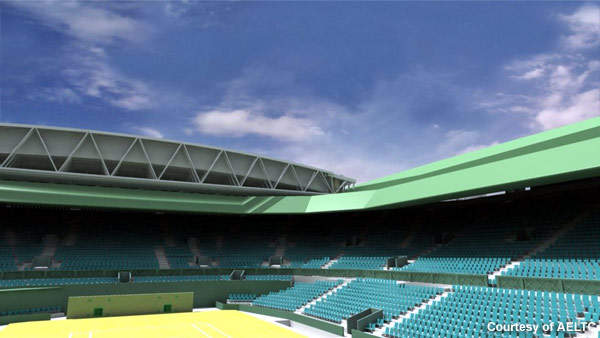On 17 May 2009, Centre Court at the All England Lawn Tennis Club (AELTC) in Wimbledon tested the functionality of its new retractable roof with upgraded 15,000-seat capacity. Designed and put in place by Hightex, 5,200m² of folding PTFE (polytetrafluoroethylene) fabric concertina will protect Centre Court from inclement weather.
Part of the long-term plan that the club announced in January 2004, the 40% translucent roof would allow natural light in but keep the dampness off the ground by controlled air conditioning. Another benefit of the roof is to maintain the optimum temperature for the growth of natural grass. The folding roof is 65m × 75m of waterproof translucent material. Galliford Try was the main contractor partnered with AELTC.
The seating capacity has been increased from 13,800 to 15,000 with an extra 470mm seat spacing. The new stand also features additional stairs and lifts.
Capita Symonds provided the structural engineering services, while Populous (Formerly HOK Sport) of London was the architect for the roof.
Wimbledon retractable roof
With a total of nine bays of structural fabric, the retractable roof is divided into two sections, with four bays in one section and five in the other. Ten steel trusses, each weighing 70t and spanning 77m, fasten the bays. Each truss is supported by a set of wheels that move along a track.
Hydraulic jacks and arms move the trusses apart and stretch the fabric between them until the north and south sections seam the court. The speed of truss deployment is 214mm a second.
The coordinated electro mechanical movement also unfolds and stretches the fabric between the trusses until the two sections meet in an overlapping seam above the middle of the court.
The GORE TENARA architectural fabric, a patented PTFE material, is 0.5mm thick. The arch shape of the roof provides a clearance of 16m for high balls. The roof can withstand up to 43mph (69km/h) wind speeds.
In preparation for closing the roof, one section is parked in its folded state at the north end of the court while the other is parked at the south end.
Euro Quality Coatings (EQC) coated the new retractable roof system with Interpon D1036 polyester powder, coating the aluminum flashings and fabrications around the retractable roof to match the roof design.
Air-circulation system
The circulation system will have to pump in 8l of fresh air a second, per person, to keep the temperature in the closed stadium at specified levels (24°C ± 2°C, with 50% ±10% relative humidity based on ambient conditions of 27°C with 72% relative humidity). It will also pump 143,000l of conditioned air a second to insulate the grass court from moisture.
It takes about ten minutes for the roof to unfold completely. During this time, traditional covering of the pitch will help the game to resume within ten to 30 minutes depending on the weather. The roof also improves the stadium’s acoustics.
Lighting facilities
When natural light fails to meet visibility levels, it can be aided by a bespoke-design sports lighting system installed on the trusses. There are 72 indirect and 48 direct truss-mounted sports luminaries. On the turf, horizontal lighting level is 3,200 lux and for service and shots in the air, the vertical lighting level is 1,900 lux.
History of the Wimbledon roof
The original roof, built in the inaugural year 1922, was replaced in 1992. After the 2006 championships the roof was removed and 2007 championships were played with no roof.
The new Centre Court roof comprises two distinct roofs. The main fixed roof is modelled on the 1922 dodecahedron form and covers the perimeter of the court. Above the fixed perimeter roof, the lightweight fabric retractable roof is set to retain the open-to-air stadium and focus spectators’ attention on the action.
The placement of the roof followed the demolition and reconstruction of the existing east wing, together with the provision of an additional six rows of seating around the east, north and west wings.
On 17 May 2009, Andre Agassi with Stefanie Maria Graf and Tim Henman with Kim Clijsters inaugurated the closed-court game and successfully tested the air-conditioning system under the new roof. They were joined by opera singers Katherine Jenkins and Faryl Smith in the inaugural ceremony.

